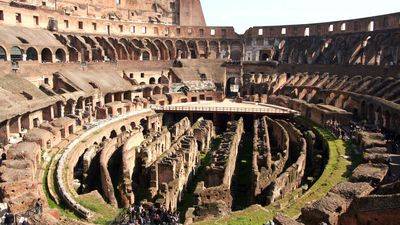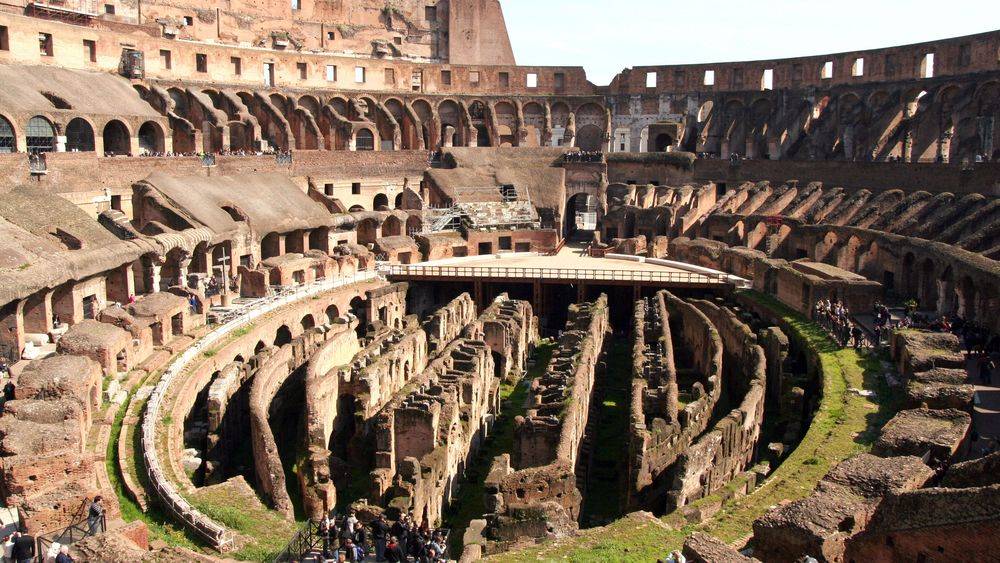Built during the 1st century in Rome, the Colosseum has a long history that takes its sources in a fertile region. The many events associated with it prove that the ancient genius in the field of construction was really strong to the extent that this amphitheater, the largest in the Roman Empire, is still standing today. And if we look at it more closely, it is not the man who destroyed it, it is essentially natural disasters.

The Colosseum
Here are the main events in its history, in chronological order.
Read the full story of the Colosseum.
Chronology
| Prehistory |
A small valley In prehistoric times the place where the Colosseum is currently located was a collection area for runoff. In the long run a small pond was formed between the hills. |
| 508-44 BC |
Roman Empire This is the time of the Roman Republic. In the early days of this Republic the Romans came to settle on the edge of the Tiber. To dry the pond they built drains and replaced the swamps with a city. Temples, buildings, public spaces appear. The area of the ancient pond is at the junction between 4 sectors of ancient Rome. |
| 64 |
The fire of Rome On July 19, a fire broke out in Rome. It spreads rapidly and consumes much of the city, which is then destroyed. The disaster lasted 6 days. Once extinguished, the Emperor Nero ordered the building of a palace on the area of the old pond. He razed the ruins of this area and replaced them with a series of beautiful houses, gardens, and even an artificial lake. This place becomes a symbol of power. |
| 71 |
Beginning of the construction of the Colosseum When Nero died, his successor Vespasian ordered that the Nero's built area be returned to the people. His palace is then destroyed and replaced by buildings for the use of the people. The main one will be a big amphitheater, a symbol of the gathering of the people. |
| 80 |
Inauguration of the Colosseum Vespasian meurt en 79, il ne verra pas son amphithéâtre fini. C'est son fils Titus qui l'inaugure, en 80 après JC. Il offre à cette occasion un spectacle gigantesque, une reconstitution d'une bataille navale. |
| 81 |
First improvement work As soon as he seized power, Emperor Domitian, brother of Titus, ordered improvements to the Colosseum. He builds the third floor and digs the hypogeum, in the ground of the arena. The hypogeum represents the backstage of the show, from where we could bring up in the arena what we wanted to see. |
| IIe siècle |
Premières réparations During the reign of Anthony, during the second century, a fire spread to the city. 350 houses were destroyed but this fire caused less damage than that under Nero, 3 centuries ago. The fire having reached the Colosseum of the works was engaged for repairs. |
| 217 |
Second fire A second fire caused the almost complete destruction of the Colosseum, which suffered its worst day on August 2, 217. The fire that began that day burned for several days the structures of the building, especially the tiers of the third floor, wood. The building is then in ruins, and Emperor Macrinus had to start major works that lasted 30 years. |
| 240 |
Second Inauguration It was not until 240 that the Colosseum was advanced enough to be inaugurated. We are then under the reign of Alexander Severus, and it will remain after many repairs before it is completely restored. But the inauguration still takes place, the building being dedicated to the Gods. |
| 250 et 254 |
New fire Twice, in 250 and 254, a new fire broke out at the Colosseum, which was again damaged. But repairs will be faster, every time. |
| 262 |
First earthquake An earthquake second to North Africa and the Eastern Roman Empire, the tremor is violent. The damage in Rome is important and the Colosseum and slightly touched. |
| 404 |
Last gladiator fight The last gladiatorial fight at the Colosseum took place in 404. The Emperor Theodosius having converted to Christiannism he ordered the end of the persecutions of Christians as well as any reminder to paganism. Gladiator fights are finally abolished. |
| 410 |
Sacred Rome In 410 the Visigoths break in Europe, along with other Germanic peoples. The Visigoths move on Rome and provoke the siege of the city. The Romans, unable to bury their dead outside the walls, converted the Colosseum into a large cemetery. At the end of the siege, when the Visigoths manage to enter the city, they sack it. Soon after, 2m of earth was added to the graves to bury them more effectively. |
| 420 |
Restoration The co-rulers Honorius and Thédose II undertakes restoration work that they pay on their own funds. From now on all the collapsed stones will be recovered for reuse, which will gradually destroy entire sections of the Colosseum. |
| 429 |
New earthquake The Colosseum suffered a new earthquake in 429, under Theodosius II and Valentin III. New repairs took place on this occasion. |
| 443 |
3rd earthquake Four years later a new earthquake hits Rome, the Colosseum is hit again. This time it is the Prefect Lampadius who will make the repairs on his personal money. |
| 455 |
Rampage of the Vandals The Vandals' German people arrive in Rome and ransack the city for 15 days under Genseric's orders. |
| 470, 484, 508 |
Restorations The end of the fifth century saw a series of restoration take place on the Colosseum. We have dedications thanks to engraved stones, they give most of the time the author of the works. |
| 523 |
Last hunt It was in 523 that the last animal hunt took place at the Colosseum. Since the beginning this popular show consisted of observing how the "hunters" attacked their prey. This show is now over. |
| VIth-IXth century |
The Colosseum is abandoned For 4 centuries the Colosseum will no longer be used or maintained. During this time different events mark it: A road is built through the arena, the valley is partially filled with earth, and above all stones were used for other reasons, like the construction of private buildings. Gradually the Colosseum is disfigured. In the 9th century it is owned by Santa Maria Nova Church. |
| IXth-XIIIth century |
The Colosseum serves as dwellings Little by little, the church develops the interior of the Colosseum with small buildings, makes paths between the spans and organizes life on site. Houses are rented or sold there. On the north side a road is built to improve access to the monument. And for the first time we speak of "Amphitheatrum Colisei". |
| 1084 |
Arrival of the Vikings The Vikings arrive from northern Europe to Rome. The city falls quickly in their hands, they share the sectors of Rome. But they can not stop the war between the different Vikings families. One of them, the Frangipanes, settles in the Colosseum. |
| 1349 |
Earthquake In 1349 there was a strong earthquake on Europe. Many cities were affected, including Rome. It was on this occasion that the lighthouse of Alexandria finally collapsed at sea. In Rome the Colosseum was hit, but it was already partly in ruins before, anyway. |
| 1382 |
Transfer of ownership The Archconfraternity of St Savior buys one-third of the Colosseum, the other two-thirds of which are the property of the Church and the Roman Senate. At the same time, they get the rights to use materials. This archconfraternity always has its insignia engraved in the stone of the Colosseum. |
| XVth-XVIIIth century |
Destruction stone by stone Until the eighteenth century the Colosseum will be gradually destroyed, the stones being sold for the construction of houses, palaces and churches of Rome. |
| 1750 |
First protective measures Considering the Colosseum as a symbolic place of the persecution of the early Christians Pope Benedict XIV forbade further destruction. It even begins restoration work to beautify the architectural ensemble. |
| 1752 |
Laying a way of the cross The archconfraternity of Jesus and Mary organizes the first procession in the Colosseum. For the occasion a way of cross is installed there. |
| 1798 |
Archaeological Park Project The Napoleonic forces conquer part of present-day Italy and enter Rome. They then administer the city and create an archaeological park project that encompasses the entire historic center. |
| Early 19th century |
Backup jobs During the first half of the 19th century, major restoration work was undertaken. These are the first important works to safeguard the monument. It was at this time that the brick buttresses were constructed which delimit the remains of the facade. |
| 1874 |
Restoration New restorations are undertaken, which allows to discover many vestiges still unknown at the time. The way of the cross is destroyed. The Colosseum takes the form that we know today. |





















